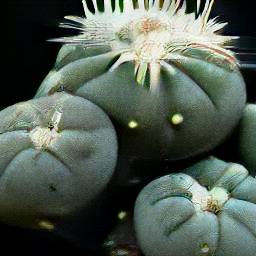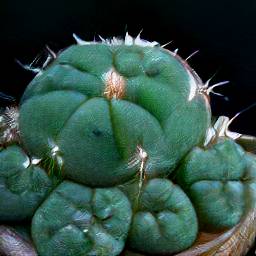Learn how to grow the peyote cactus.
Peyote (Lophophora williamsii) is a slow-growing cactus that is native to the Chihuahuan Desert in Mexico and the Southwestern United States. The cactus produces small, button-shaped fruits that are harvested and dried for use in ceremonial and medicinal purposes.
© Shamans Garden, All rights reserved.
First, What is peyote?
Peyote is a small, spineless cactus that grows in the desert regions of North America. The cactus contains a psychoactive substance called mescaline, which has been used for centuries by indigenous people in ceremonial and religious contexts. Peyote is typically consumed by chewing on the cactus or drinking a tea made from its buds. The psychoactive effects of mescaline can last for up to 12 hours, and include altered states of consciousness, visual hallucinations, and spiritual experiences. Some people who use peyote report feeling a sense of oneness with the universe, or a deep connection to nature.
Peyote is a hallucinogenic drug, which is used by Native Americans for religious purposes. It is a small, spineless cactus that contains mescaline. The drug can be ingested by eating the fleshy buttons, by drinking water in which the buttons have been soaked, or by brewing it in a tea. Peyote is typically dried and ground into a powder before being used. The experience can last anywhere from six to ten hours.
Peyote is a small, spineless cactus native to Mexico and the southern US. Its name is derived from the Nahuatl word for "divine". Peyote has been used for thousands of years by Native Americans as a medicine and a sacrament. Its psychoactive properties are said to induce a sense of spiritual oneness, connection to the divine, and understanding of one's place in the universe. Peyote was made illegal in the US in 1968 and in Mexico in 1970. However, it is still used by the Huichol and Tarahumara Indians of Mexico and the Native American Church of North America.
 |
| Picture of Peyote. How to grow this magical plant. |
How to grow peyote.
Peyote is a cactus, and like most it takes a while and is slow growing. Peyote is typically propagated from seed, but can also be propagated from cuttings. Seed germination can be erratic, so it is often best to purchase seed from a reputable source. Sow seeds on the surface of a well-draining cactus mix and keep moist. Seeds will usually germinate within 2-4 weeks. Once seedlings have germinated, they can be transplanted into individual pots. Peyote prefers a sunny location and well-draining soil. Water the cactus when the soil is dry to the touch. Peyote will typically start to produce flowers and fruits after 3-5 years. The small, button-shaped fruits can be harvested and dried for use in ceremonial and medicinal purposes.
Peyote cactus can be grown from seed or cuttings. To grow from seed, plant the seeds in a well-draining cactus mix and keep them warm and moist until they germinate. Once they germinate, transplant them into individual pots and keep them in a bright, sunny location. Water them only when the soil is dry to the touch.
To grow from cuttings, take a cutting from a healthy peyote cactus and allow the cut end to callus for a few days. Plant the cutting in a well-draining cactus mix and keep it warm and moist until it roots. Once it roots, transplant it into an individual pot and keep it in a bright, sunny location. Water it only when the soil is dry to the touch.
Peyote is a small, spineless cactus that is native to Mexico and southwestern Texas. The top of the cactus, which contains the psychoactive alkaloid mescaline, is cut off and dried to make peyote buttons. These buttons can be chewed or soaked in water to make a psychoactive tea.
Peyote has been used by indigenous people in Mexico for centuries for religious and ceremonial purposes. The psychoactive effects of peyote include visual and auditory hallucinations, as well as a sense of euphoria and well-being. Peyote is classified as a Schedule I drug in the United States, meaning that it has a high potential for abuse and no accepted medical use.
#peyote #peyotecactus #peyotestitch #peyotecommunity #peyotecrochet #peyotelove #peyotecraft #peyotebracelet #peyotekits #peyoteneedlelace #peyotejewelry #peyotebeading #peyotestitchbracelet #peyotebeadwork #peyoteaddict #peyotebeadingjewelry #peyotebeadingpattern #peyotecrafting #peyotebeadingaddict #peyotebracelets #peyotesewing #peyoteknitting #peyotezoom #peyotejewelrymaking #peyotebeadweaving #peyoteloom #peyotebeadings #peyotecuff #peyotecrafty #bhfyp

No comments:
Post a Comment